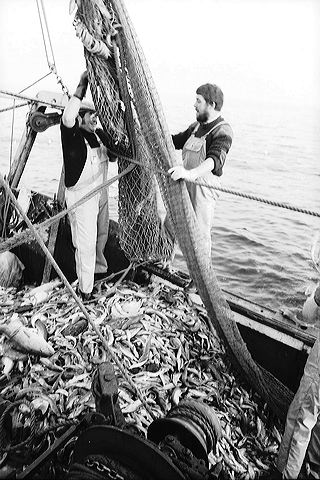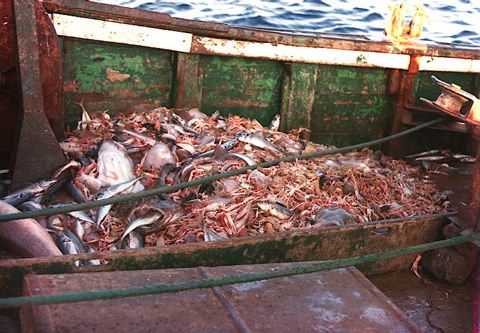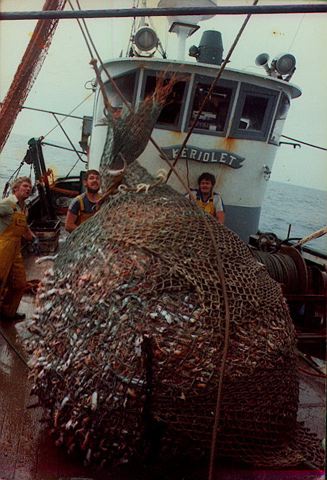The images I have added are of the Newlyn trawler, Keriolet when she was fishing for prawns (langoustine) - she was an ex-Lorient 'classic' trawler, owned and skippered by Pierre Lequillec who, when he sold the boat 'retired' and opened a bar called, what else........Le Bar Keriolet.
This title may seem a little provocative, but when you look closer this shortcut can understand.
On World Fisheries Day, November 22nd, 2013 in Saint Pierre Quiberon, Mr Tourret, president of the Maritime Prevention Institute (IMP) gave a speech on trawling and discards which goes against ideas conveyed today and promoted by the reform of the Common Fisheries Policy. Here is the transcript. « During my training at Bordeaux School of Maritime Affairs, I had an internship of 10 days aboard a ship , called « the Atlanta », from Lorient, and whose boss‘s name was Tonnerre,-a common family name - on the Isle of Groix. I had be given all the necessary recommendations, so I embarked with my oilskins, my boots, my spoon, my knife and a crate of Muscadet. I simply remind you that I was coming back from Toulon and that at this time I wasn’t very familiar with things of the Atlantic. At Toulon, there is one fish that is highly regarded : the sévereau (horse mackerel), a very good fish.
After the Atlanta's first trawl at least 500 kg of mackerel landed on deck. The sailors then threw all mackerel overboard with great shovels.
 |
| Scad and other small fish make up a by-catch with langoustine fishing sometimes |
 |
| other times the catch is almost clean with langoustine |
 |
| sometimes there is a bulk of scad, mackerel, whiting or argentines in the cod-end |
This waste management already had a peculiar connotation of risk taking. This risk taking is now becoming routine with the European regulations on discards. Years later, in 2003, I was given a post at the IMP, and as soon as in my second year in office, I began to reflect on such questions as the evolution of the business, and the need to manage discards. In 2005-2006, we suggested that the Brittany Council should launch a special study on the social dimension of risks as well as the management of discards. At the time, the Council, was sceptical, they focussed on a speech such as « the less you speak about it, the best it is, because if we talk about it, it means that we accept the idea that we must bring waste ashore » It took about 18 months to get permission to do this study. Once conducted, this study provided a true reflection on discards at sea. While going on with it, we wondered whether bringing back the waste on land was relevant or not. Obviously, the life of a man is made up of what he is doing now and reminiscences of what had been done before, and by the intersection of his past experience and the reality that he sees.
Let’s go back to 1967, I left the «Atlanta» keeping this in mind : « Bugger, why do we get rid of discards ?». I saw this as negative from an economic point of view. Upon returning to school in Bordeaux, I spoke with my oceanography teacher, Mr Percier, director of the Oceanographic Museum of Biarritz. I told him about my experience in Lorient and the horse mackerel being discarded at sea. He told me it wasn’t really serious and started giving me a personal tuition. He explained to me that « la grande vasière» of the Bay of Biscay, where we used to fish at the time, was not an environment that had existed since eternity, but this mudflat was a human construction. He explained that at the time of Julius Caesar, Europe was covered with forests, and referred to as «La Gaule chevelue». The clearing of Gaul was done in several stages. There were at least two periods of widespread clearing : during the Neolithic on one hand, and especially the clearings undertaken in the year 1000, when the population of Gaul increased dramatically. The once clear rivers became muddy. Several waves of mud were discharged into the Bay of Biscay and modified the geology of the sea bed. As a consequence, a special milieu developed into the pristine condition of « la grande Vasière » It’s very simple : if « La Grande Vasière»were to be left in its actual state, we would have got a forest of seapen and we would have got something that we might have had in the Landes forest if it had been left alone. Birch trees would have outweighed pines and the result would have been an impenetrable forest and finally a very limited biodiversity. He explained to me that la Grande Vasière had become productive from the moment when it had been trawled. The idea was that if we had something that had returned to the state of wasteland, this wasteland was not a biodiversity reserve, quite the contrary. With passing trawlers aerating the mudflat it made it possible for interesting fossorial decapoda to settle (not the small squat lobster in which there is hardly anything to eat, but the big langoustine). In addition, thanks to the discards, a trophic circuit was created in which benthic species to be found at the bottom feed on discarded species. There is a balance taking place on the seabed due to the action of man.
This is a subtle story to tell. I then had the opportunity to evoke the case of the box (reserve) extending from Penmarc’h to belle Isle with André Le Berre (nicknamed Dédé). Five years ago, at a time when talks about discards were starting, I had a talk with Dédé about this, and he told me : « When the box was reopened, we discovered that there was nothing. It did not serve in any way to increase the density of fish». All these things criss-crossed, the pieces of the puzzle were met : the sailors throwing horse mackerel overboard with spades and taking risks, the conversation with professor Percier on the origin of la grande Vasière, Dédé’s remarks on of the non- productivity of the box. We are faced with complex phenomena. The point is to make people who have simple ideas understand the complexity of it, knowing that we must reduce this complexity. On the one hand, there is Michel Serre who reminds us that the world is complex and that the prerogative of science is in understanding this complexity, and on the other hand, speeches that will simplify it to a maximum…
